Mapping Sustainability across the World: Signs, Challenges and Opportunities for Democratic Countries
Abstract
:1. Introduction
1.1. Sustainability Agenda at the Beginning of the XXI-st Century
1.2. Sustainability Nexus Democracy: Theoretical Challenges and Political Issues
2. Research Methods
2.1. Theoretical Research Design. Objectives, Questions and Hypothesis
2.2. Data, Methods and Quantitative Design
3. Results
3.1. Mapping Sustainability across the World: Challenges for Democratic Regimes
3.2. Two Models of Sustainable Development: Asian Economic Strategy and Western Democratic Partnership for Goals
4. Discussion
5. Conclusions
Author Contributions
Funding
Institutional Review Board Statement
Informed Consent Statement
Data Availability Statement
Conflicts of Interest
References
- Tisdell, C.A. Economic, social and political issues raised by the COVID-19 pandemic. Econ. Anal. Policy 2020, 68, 17–28. [Google Scholar] [CrossRef]
- Ashraf, N.B. Economic impact of government interventions during the COVID-19 pandemic: International evidence from financial markets. J. Behav. Exp. Financ. 2020, 27, 100371. [Google Scholar] [CrossRef]
- Li, Y.; Mutchler, J.E. Older Adults and the Economic Impact of the COVID-19 Pandemic. J. Aging Soc. Policy 2020, 32, 477–487. [Google Scholar] [CrossRef]
- Buheji, M.; da Costa Cunha, M.; Beka, G.; Mavrić, B.; De Souza, Y.L.; da Costa Silva, S.S.; Hanafi, M.; Yein, T.C. The Extent of COVID-19 Pandemic Socio-Economic Impact on Global Poverty. A Global Integrative Multidisciplinary Review. Am. J. Econ. 2020, 10, 213–224. [Google Scholar] [CrossRef]
- McBride, O.; Murphy, J.; Shevlin, M.; Gibson-Miller, J.; Hartman, T.K.; Hyland, P.; Levita, L.; Mason, L.; Martinez, A.P.; McKay, R.; et al. Monitoring the psychological, social, and economic impact of the COVID-19 pandemic in the population: Context, design and conduct of the longitudinal COVID-19 psychological research consortium (C19PRC) study. Int. J. Methods Psychiatr. Res. 2020, 30, e1861. [Google Scholar] [CrossRef]
- Hevia, C.; Neumeyer, A. A Conceptual Framework for Analyzing the Economic Impact of COVID-19 and its Policy Implications. UNDP Lac COVID-19 Policy Doc. Ser. 2020, 1, 29. [Google Scholar]
- McKee, M.; Murphy, A. Russia invades Ukraine again: How can the health community respond? Join others in calling for an immediate end to the fighting. BMJ 2022, 376, 1–2. [Google Scholar] [CrossRef]
- Leon, D.A.; Jdanov, D.; Gerry, C.G.; Grigoriev, P.; Jasilionis, D.; McKee, M.; Meslé, F.; Penina, O.; Twigg, J.; Vallin, J.; et al. The Russian invasion of Ukraine and its public health consequences. Lancet Reg. Health Eur. 2022, 15, 1–2. [Google Scholar] [CrossRef]
- Oxford Analytica. Evidence tilts towards Ukraine war likelihood. Exp. Brief. 2022. [Google Scholar] [CrossRef]
- Boese, V.A.; Edgell, A.B.; Hellmeier, S.; Maerz, S.F.; Lindberg, S.I. How democracies prevail: Democratic resilience as a two-stage process. Democratization 2021, 28, 885–907. [Google Scholar] [CrossRef]
- Guasti, P. The Impact of the COVID-19 Pandemic in Central and Eastern Europe. The Rise of Autocracy and Democratic Resilience. Democr. Theory 2020, 7, 47–60. [Google Scholar] [CrossRef]
- Lührmann, A. Disrupting the autocratization sequence: Towards democratic resilience. Democratization 2021, 28, 1017–1039. [Google Scholar] [CrossRef]
- Merkel, W.; Lührmann, A. Resilience of democracies: Responses to illiberal and authoritarian challenges. Democratization 2021, 28, 869–884. [Google Scholar] [CrossRef]
- López, R.; Toman, M.A. Economic Development and Environmental Sustainability. In New Policy Options; Oxford University Press: New York, NY, USA, 2006. [Google Scholar]
- Hák, T.; Moldan, B.; Dahl, A.L. Sustainability Indicators. A Scientific Assessment; Island Press: Washington, DC, USA, 2007. [Google Scholar]
- Edwards, A.R. The Sustainability Revolution. Portrait of a Paradigm Shift; New Society Publishers: Gabriola Island, BC, Canada, 2005. [Google Scholar]
- Bell, S.; Morse, S. Sustainability Indicators Measuring the Immeasurable? 2nd ed.; Earthscan: London, UK, 2008. [Google Scholar]
- Choucri, N.; Mistree, D.; Haghseta, F.; Mezher, T.; Baker, W.R.; Ortiz, C.I. Mapping Sustainability Knowledge e-Networking and the Value Chain; Springer: Dordrecht, The Netherlands, 2007. [Google Scholar]
- Steger, U. The Business of Sustainability. Building Industry Cases for Corporate Sustainability; Palgrave Macmillan: New York, NY, USA, 2004. [Google Scholar]
- Hawkins, D.E. Corporate Social Responsibility. In Balancing Tomorrow’s Sustainability and Today’s Profitability; Palgrave Macmillan: New York, NY, USA, 2006. [Google Scholar]
- Méndez-Picazo, M.T.; Galindo-Martín, M.A.; Castaño-Martínez, M.S. Effects of sociocultural and economic factors on social entrepreneurship and sustainable development. J. Innov. Knowl. 2020, 6, 69–77. [Google Scholar] [CrossRef]
- Dalevska, N.; Khobta, V.; Kwilinski, A.; Kravchenko, S. A model for estimating social and economic indicators of sustainable development. Entrep. Sustain. Issues 2019, 6, 1839–1860. [Google Scholar] [CrossRef]
- Schroeder, P.; Anggraeni, K.; Weber, U. The Relevance of Circular Economy Practices to the Sustainable Development Goals. J. Ind. Ecol. 2019, 23, 77–95. [Google Scholar] [CrossRef] [Green Version]
- Suárez-Eiroa, B.; Fernández, E.; Méndez-Martínez, G.; Soto- Oñate, D. Operational principles of circular economy for sustainable development: Linking theory and practice. J. Clean. Prod. 2019, 214, 952–961. [Google Scholar] [CrossRef]
- Polasky, S.; Kling, C.L.; Levin, S.A.; Carpenter, S.R.; Daily, G.C.; Ehrlich, P.R.; Heal, G.M.; Lubchenco, J. Role of economics in analyzing the environment and sustainable development. Proc. Natl. Acad. Sci. USA 2019, 116, 5233–5238. [Google Scholar] [CrossRef] [Green Version]
- Morozova, I.A.; Popkova, E.G.; Litvinova, T.N. Sustainable development of global entrepreneurship: Infrastructure and perspectives. Int. Entrep. Manag. J. 2019, 15, 589–597. [Google Scholar] [CrossRef]
- Mensah, J. Sustainable development: Meaning, history, principles, pillars, and implications for human action: Literature review. Cog. Soc. Sci. 2019, 5, 1683296. [Google Scholar] [CrossRef]
- Neumayer, E. Human Development and Sustainability. J. Hum. Dev. Capab. 2012, 13, 561–579. [Google Scholar] [CrossRef]
- Neumayer, E. The human development index and sustainability—A constructive proposal. Ecol. Econ. 2001, 39, 101–114. [Google Scholar] [CrossRef]
- Wilkinson, A.; Hill, M.; Gollan, P. The sustainability debate. IJOPM 2001, 21, 1492–1502. [Google Scholar] [CrossRef]
- Spreitzer, G.; Porath, C.; Gibson, C. Toward human sustainability: How to enable more thriving at work. Organ. Dyn. 2012, 41, 155–162. [Google Scholar] [CrossRef]
- Nilashi, M.; Rupani, P.F.; Rupani, M.M.; Kamyab, H.; Shao, W.; Ahmadi, H.; Rashid, T.A.; Aljojo, N. Measuring sustainability through ecological sustainability and human sustainability: A machine learning approach. J. Clean. Prod. 2019, 240, 118162. [Google Scholar] [CrossRef]
- Secundo, G.; Ndou, V.; Del Vecchio, P.; De Pascale, G. Sustainable development, intellectual capital and technology policies: A structured literature review and future research agenda. Technol. Forecast. Soc. Chang. 2020, 153, 119917. [Google Scholar] [CrossRef]
- Handa, N. Education for Sustainability through Internationalisation. In Transnational Knowledge Exchange and Global Citizenship; Palgrave MacMillan: London, UK, 2018. [Google Scholar]
- Gomez Martins, A. Teaching and researching on sustainability: The case of an interdisciplinary initiative at a higher education institution. In Higher Education and Sustainability Opportunities and Challenges for Achieving Sustainable Development Goals; Azeiteiro, U.M.M., Davim, J.P., Eds.; CRC Press Taylor & Francis Group: New York, NY, USA, 2020; pp. 133–150. [Google Scholar]
- Nhamo, G.; Mjimba, V. Sustainable Development Goals and Institutions of Higher Education; Springer Nature: Basel, Switzerland, 2020. [Google Scholar]
- Steele, W.; Rickards, L. Higher Education, A Transformative Agenda? Palgrave Macmillan: Cham, Switzerland, 2021. [Google Scholar]
- McCowan, T. Higher Education for and beyond the Sustainable Development Goals; Palgrave Macmillan: Cham, Switzerland, 2021. [Google Scholar]
- The United Nations Development Programme. UNDP—The Sustainable Development Goals Report 2017. Available online: https://unstats.un.org/sdgs/report/2017/ (accessed on 2 February 2022).
- Alaimo, L.; Ciacci, A.; Ivaldi, E. Measuring Sustainable Development by Non-aggregative Approach. Soc. Ind. Res. 2021, 157, 101–122. [Google Scholar] [CrossRef]
- Van Zanten, J.A.; Van Tulder, R. Towards nexus-based governance: Defining interactions between economic activities and Sustainable Development Goals (SDGs). Int. J. Sustain. Dev. World Ecol. 2020, 28, 210–226. [Google Scholar] [CrossRef]
- Lu, Y.; Nakicenovic, N.; Visbeck, M.; Stevance, A.S. Five priorities for the UN Sustainable Development Goals. Nature 2015, 520, 432–433. [Google Scholar] [CrossRef] [Green Version]
- Dvarioniene, J.; Grecu, V.; Lai, S. Four Perspectives of Applied Sustainability: Research Implications and Possible Integrations. In Proceedings of the Computational Science and Its Applications—ICCSA 201, 17th International Conference Trieste, Proceedings, Part VI, Trieste, Italy, 3–6 July 2017. [Google Scholar]
- Moyer, J.; Hedden, S. Are we on the right path to achieve the sustainable development goals? World Dev. 2020, 127, 104749. [Google Scholar] [CrossRef]
- Sachs, J.D. The Age of Sustainable Development; Columbia University Press: New York, NY, USA, 2015. [Google Scholar]
- Nerini, F.F.; Sovacool, B.; Hughes, N.; Cozzi, L.; Cosgrave, E.; Howells, M.; Tavoni, M.; Tomei, J.; Zerriffi, H.; Milligan, B. Connecting climate action with other Sustainable Development Goals. Nat. Sustain. 2019, 2, 674–680. [Google Scholar] [CrossRef]
- Fritz, S.; See, L.; Carlson, T.; Haklay, M.M.; Oliver, J.L.; Fraisl, D.; Mondardini, R.; Brocklehurst, M.; Shanley, L.A.; Schade, S.; et al. Citizen science and the United Nations Sustainable Development Goals. Nat. Sustain. 2019, 2, 922–930. [Google Scholar] [CrossRef]
- Silvestre, B.S.; Tîrca, D.M. Innovations for sustainable development: Moving toward a sustainable future. J. Clean. Prod. 2019, 208, 325–332. [Google Scholar] [CrossRef]
- Fonseca, L.M.; Domingues, J.P.; Dima, A.M. Mapping the Sustainable Development Goals Relation-ships. Sustainability 2020, 12, 3359. [Google Scholar] [CrossRef] [Green Version]
- Miola, A.; Schiltz, F. Measuring sustainable development goals performance: How to monitor policy action in the 2030 Agenda implementation? Ecol. Econ. 2019, 164, 106373. [Google Scholar] [CrossRef]
- Nilsson, M.; Griggs, D.; Visbeck, M. Policy: Map the interactions between Sustainable Development Goals. Nature 2016, 534, 320–322. [Google Scholar] [CrossRef]
- Salvia, A.L.; Filho, W.L.; Brandli, L.L.; Griebeler, J.S. Assessing research trends related to Sustainable Development Goals: Local and global issues. J. Clean. Prod. 2019, 208, 841–849. [Google Scholar] [CrossRef] [Green Version]
- Griggs, D. Sustainable development goals for people and planet. Nature 2013, 495, 305–307. [Google Scholar] [CrossRef]
- Lucia, U.; Fino, D.; Grisolia, G. A thermoeconomic indicator for the sustainable development with social considerations. A thermoeconomy for sustainable society. Environ. Dev. Sustain. 2022, 24, 2022–2036. [Google Scholar] [CrossRef]
- Filho, W.L.; Brandli, L.L.; Salvia, A.L.; Rayman-Bacchus, L.; Platje, J. COVID-19 and the UN Sustainable Development Goals: Threat to Solidarity or an Opportunity? Sustainability 2020, 12, 5343. [Google Scholar] [CrossRef]
- Naidoo, R.; Fisher, B. Sustainable Development Goals: Pandemic reset. Nature 2020, 583, 198–201. [Google Scholar] [CrossRef]
- Hakovirta, M.; Denuwara, N. How COVID-19 Redefines the Concept of Sustainability. Sustainability 2020, 12, 3727. [Google Scholar] [CrossRef]
- Pohoryles, R.J. Sustainable development, innovation and democracy and democracy. What role for the regions? Innovation 2007, 20, 183–190. [Google Scholar] [CrossRef]
- Joseph, J. Sustainable development and democracy in the megacities. Dev. Pract. 2001, 11, 218–231. [Google Scholar] [CrossRef]
- Munslow, B.; Ekoko, F.E. Is democracy necessary for sustainable development? Democratization 1995, 2, 158–178. [Google Scholar] [CrossRef]
- Mangesh, A. Democracy and sustainable development. IOSR-JHSS 2014, 19, 40–42. [Google Scholar] [CrossRef]
- Sénit, C.A. Leaving no one behind? The influence of civil society participation on the Sustainable Development Goals. EPC Politics Space 2020, 38, 693–712. [Google Scholar] [CrossRef] [Green Version]
- Imran, S.; Javaid, F. Interlinkage between Democracy and Sustainable Development. Rev. Econ. Dev. Stud. 2017, 3, 159–166. [Google Scholar] [CrossRef] [Green Version]
- Söderbaum, P. Democracy and sustainable development: Implications for science and economics. Real-World Econ. Rev. 2012, 60, 107–119. [Google Scholar]
- Söderbaum, P. Reconsidering economics in relation to sustainable development and democracy. J. Philos. Econ. 2019, 13, 19–38. [Google Scholar]
- Lindberg, S.I.; Teorell, J.; Coppedge, M.; Gerring, J. V-Dem: A new way to measure democracy. J. Dem. 2014, 25, 159–169. [Google Scholar] [CrossRef]
- Pickering, J.; Hickmann, T.; Backstrand, K.; Kalfagianni, A.; Bloomfield, M.; Mert, A.; Ransan-Cooper, H.; Lo, A. Democratising sustainability transformations: Assessing the transformative potential of democratic practices in environmental governance. Earth Syst. Gov. J. 2022, 11, 100131. [Google Scholar] [CrossRef]
- Glass, L.M.; Newig, J. Governance for achieving the Sustainable Development Goals: How important are participation, policy coherence, reflexivity, adaptation and democratic institutions? Earth Syst. Gov. J. 2019, 2, 100031. [Google Scholar] [CrossRef]
- Ting, Y.C.; Lin, T.H. For security or sustainability? Investigating the global nexus of nuclear power, democracies, and civil society. Energy Res. Soc. Sci. 2021, 81, 102284. [Google Scholar] [CrossRef]
- Fung, A. Associations and Democracy: Between Theories, Hopes, and Realities. Annu. Rev. Sociol. 2003, 29, 515–539. [Google Scholar] [CrossRef] [Green Version]
- Hammond, J.M. Sustainability as a cultural transformation: The role of deliberative democracy. Environ. Pol. 2020, 29, 173–192. [Google Scholar] [CrossRef]
- International Institute for Democratic and Electoral Assistance (IDEA). The Sustainable Development Goals and the Global State of Democracy Indices, The Global State of Democracy in Focus. Available online: https://www.idea.int/publications/catalogue/sustainable-development-goals-and-global-state-democracy-indices (accessed on 5 March 2022).
- Monkelbaan, J. Governance for the Sustainable Development Goals Exploring an Integrative Framework of Theories, Tools, and Competencies; Springer Nature: Singapore, 2019. [Google Scholar]
- Achterberg, W. Sustainability, community and democracy. In Democracy and Green Political Thought. Sustainability, Rights and Citizenship; Doherty, B., De Geus, M., Eds.; Routledge: London, UK; New York, NY, USA, 1996. [Google Scholar]
- Diamond, L. Ill Winds: Saving Democracy from Russian Rage, Chinese Ambition, and American Complacency; Penguin Press: New York, NY, USA, 2019. [Google Scholar]
- Diamond, L. Facing up to the democratic recession. J. Dem. 2015, 26, 141–155. [Google Scholar] [CrossRef]
- Applebaum, A. Twilight of Democracy: The Seductive Lure of Authoritarianism; Doubleday, Penguin Random House LLC: New York, NY, USA, 2020. [Google Scholar]
- Ayers, A.J.; Saad-Filho, A. The twilight of formal democracy: Contradictions of accumulation and the political crisis of neoliberalism. J. Aust. Political Econ. 2020, 86, 230–255. [Google Scholar] [CrossRef]
- The Economist Intelligence Unit. Democracy Index. Available online: https://www.eiu.com/n/campaigns/democracy-index-2020/ (accessed on 5 February 2022).
- Sustainable Development Report. Track Progress and Trends on Achieving the Sustainable Development Goals for all 193 UN Member States. Available online: https://dashboards.sdgindex.org/ (accessed on 5 February 2022).
- Sustainable Development Report. Sustainable Development Report 2021. Available online: https://sdgs.un.org/goals (accessed on 5 February 2022).
- Strand, R.; Freeman, R.E.; Hockerts, K. Corporate Social Responsibility and Sustainability in Scandinavia: An Overview. J. Bus. Ethics 2015, 127, 1–15. [Google Scholar] [CrossRef] [Green Version]
- Pierce, J.T.; Dale, D. Communities, Development, and Sustainability across Canada; UBC Press: Vancover, BC, Canada, 1999. [Google Scholar]
- Fedderke, J. Sustainable growth in South Africa. In Growth and Sustianability in Brazil, China, India, Indonesia and South Africa; De Mello, L., Ed.; OECD: Washington, DC, USA, 2010; Available online: https://www.oecd.org/economy/growth/chapter5sustainablegrowthinsouthafrica.htm (accessed on 15 February 2022).
- Fan, G.; Wang, X. China towards 2020: Growth performance and sustainability. In Growth and Sustianability in Brazil, China, India, Indonesia and South Africa; De Mello, L., Ed.; OECD: Washington, DC, USA, 2010; Available online: https://www.oecd.org/economy/growth/chapter2chinatowards2020growthperformanceandsustainability.htm (accessed on 15 February 2022).
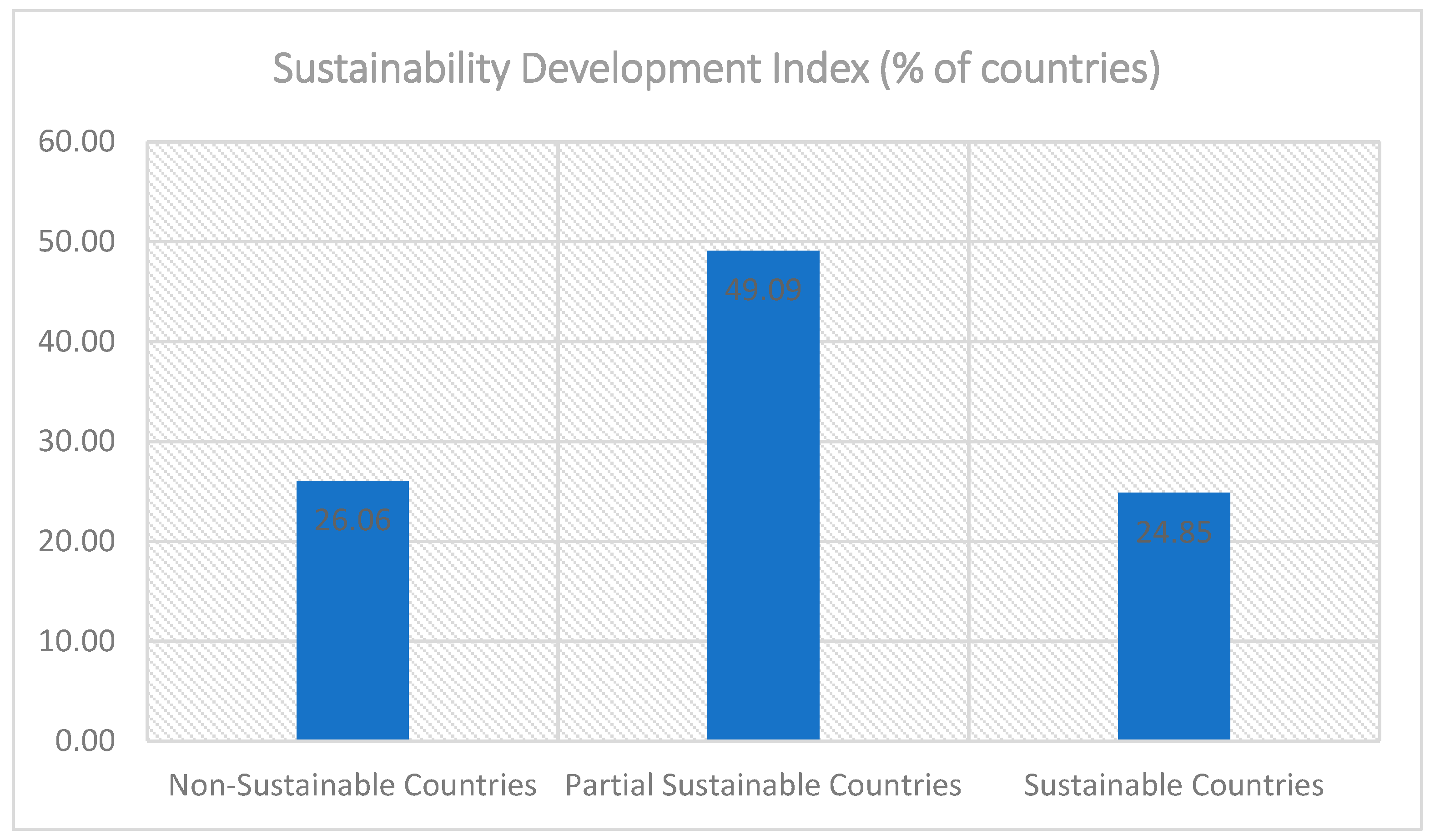
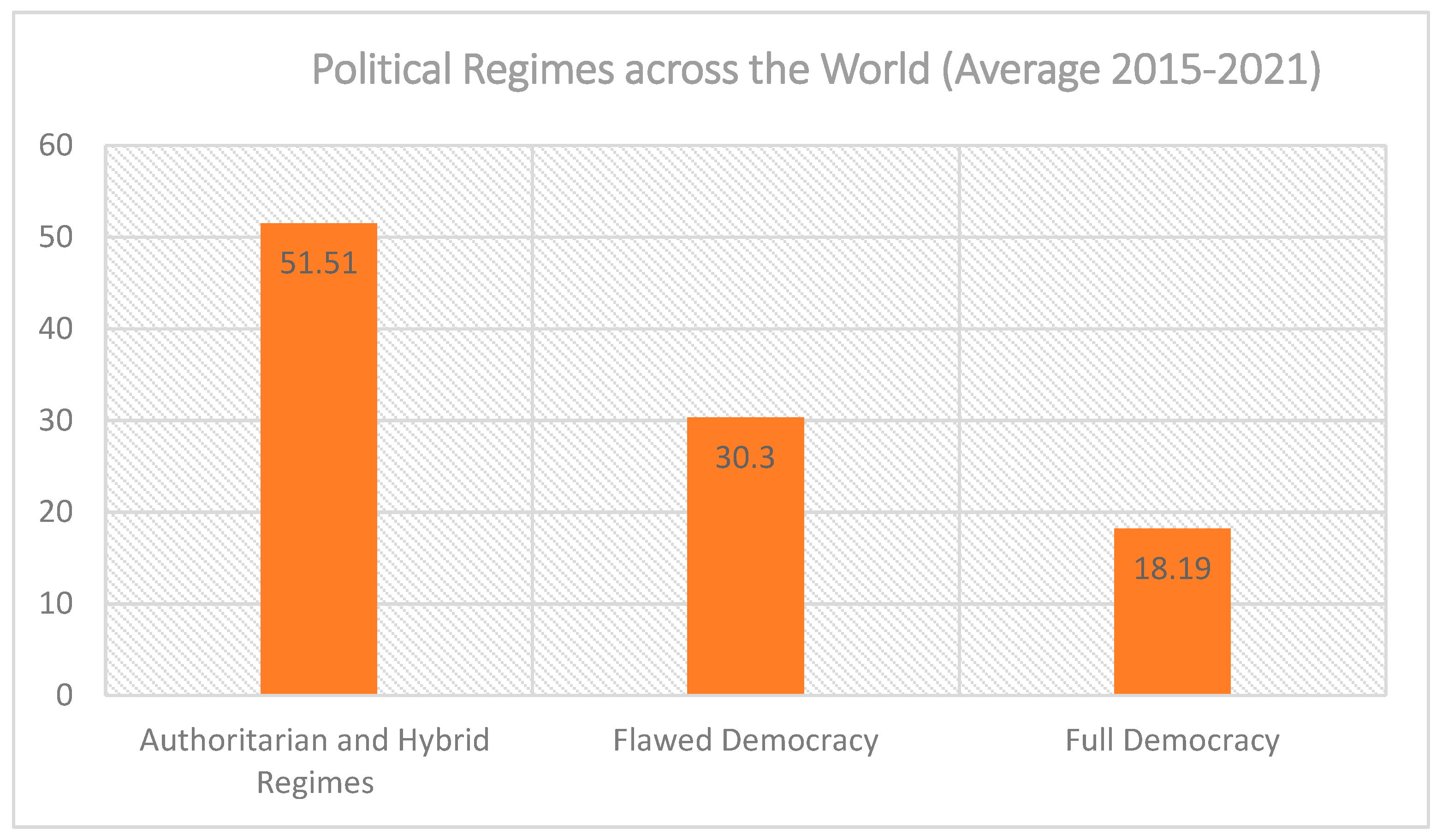
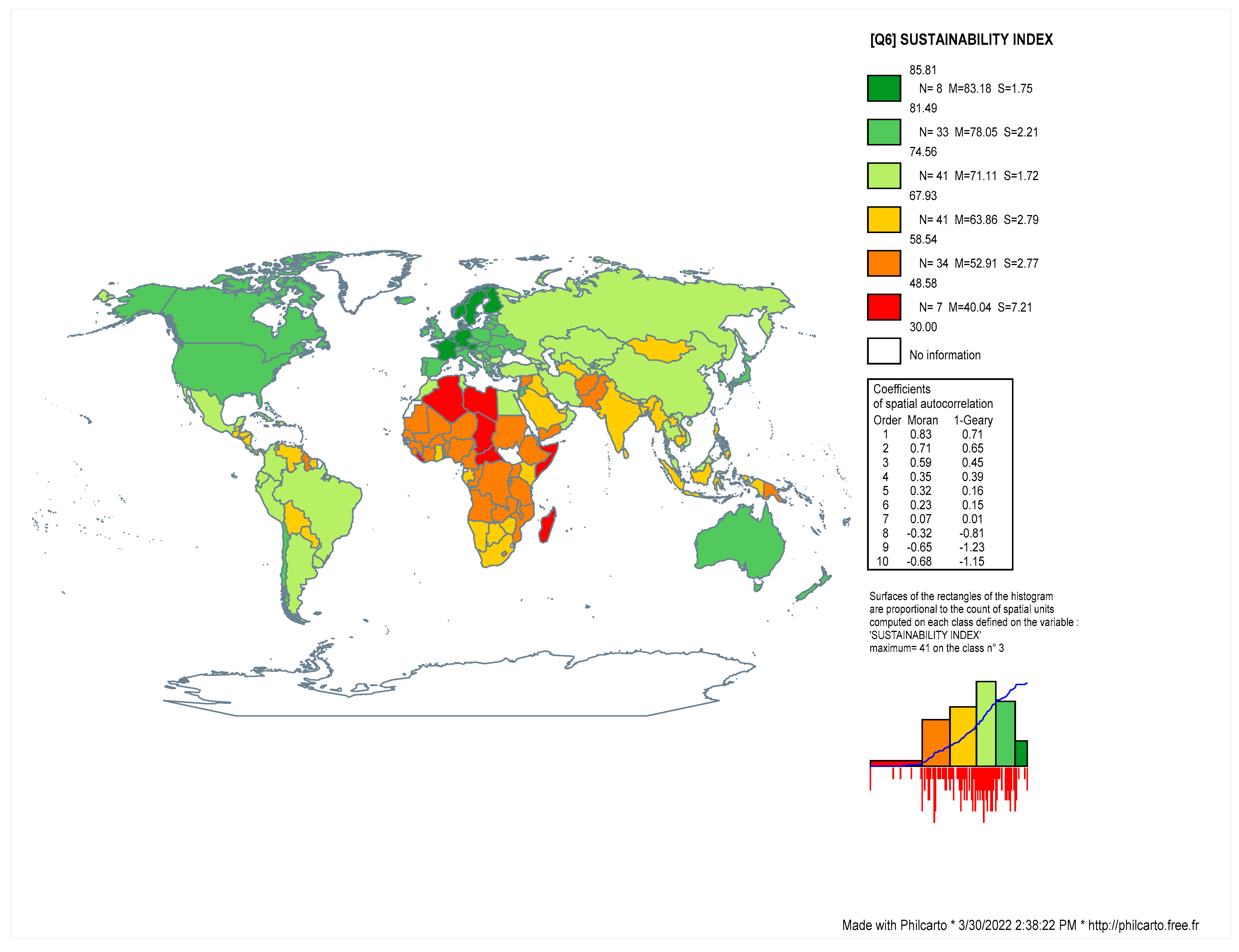

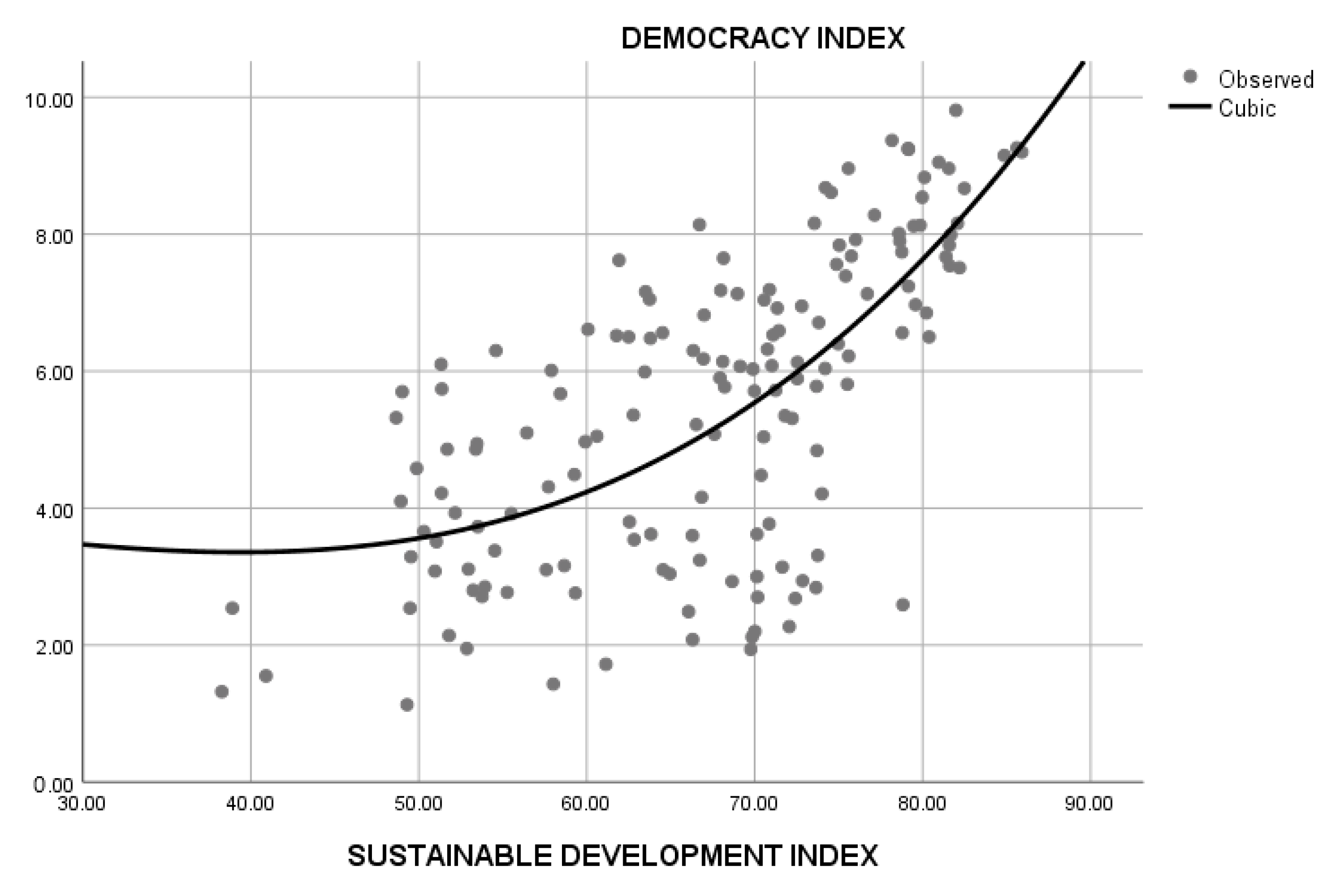
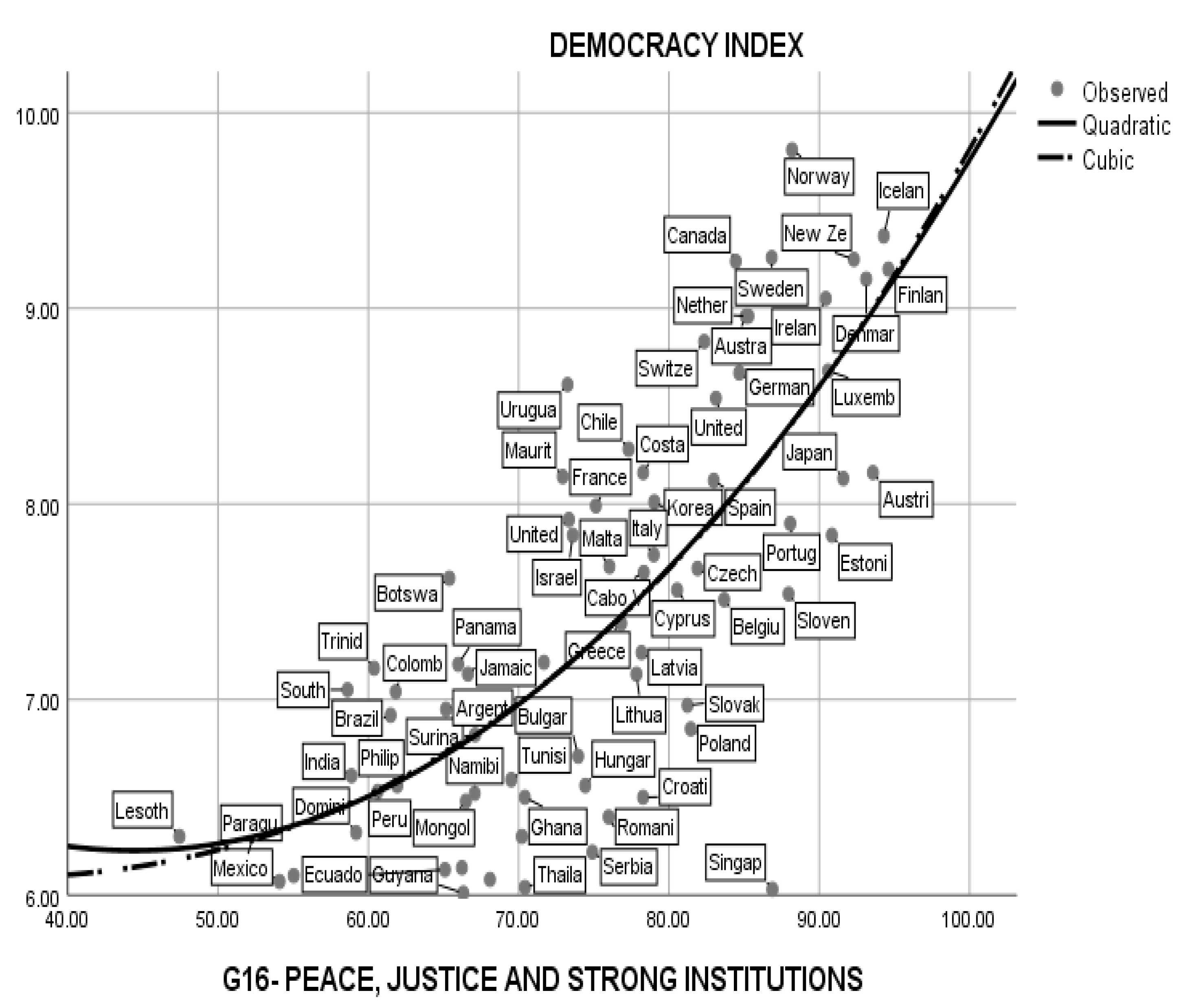
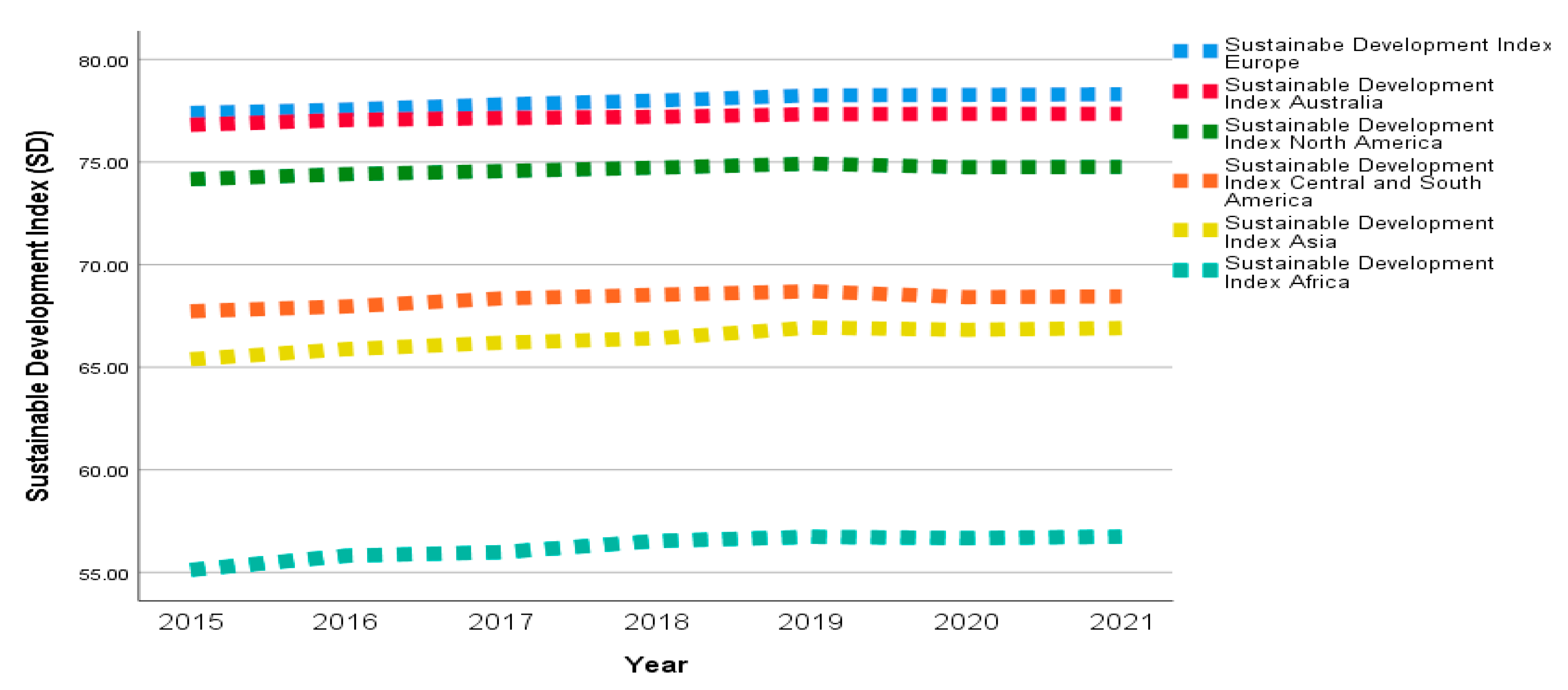
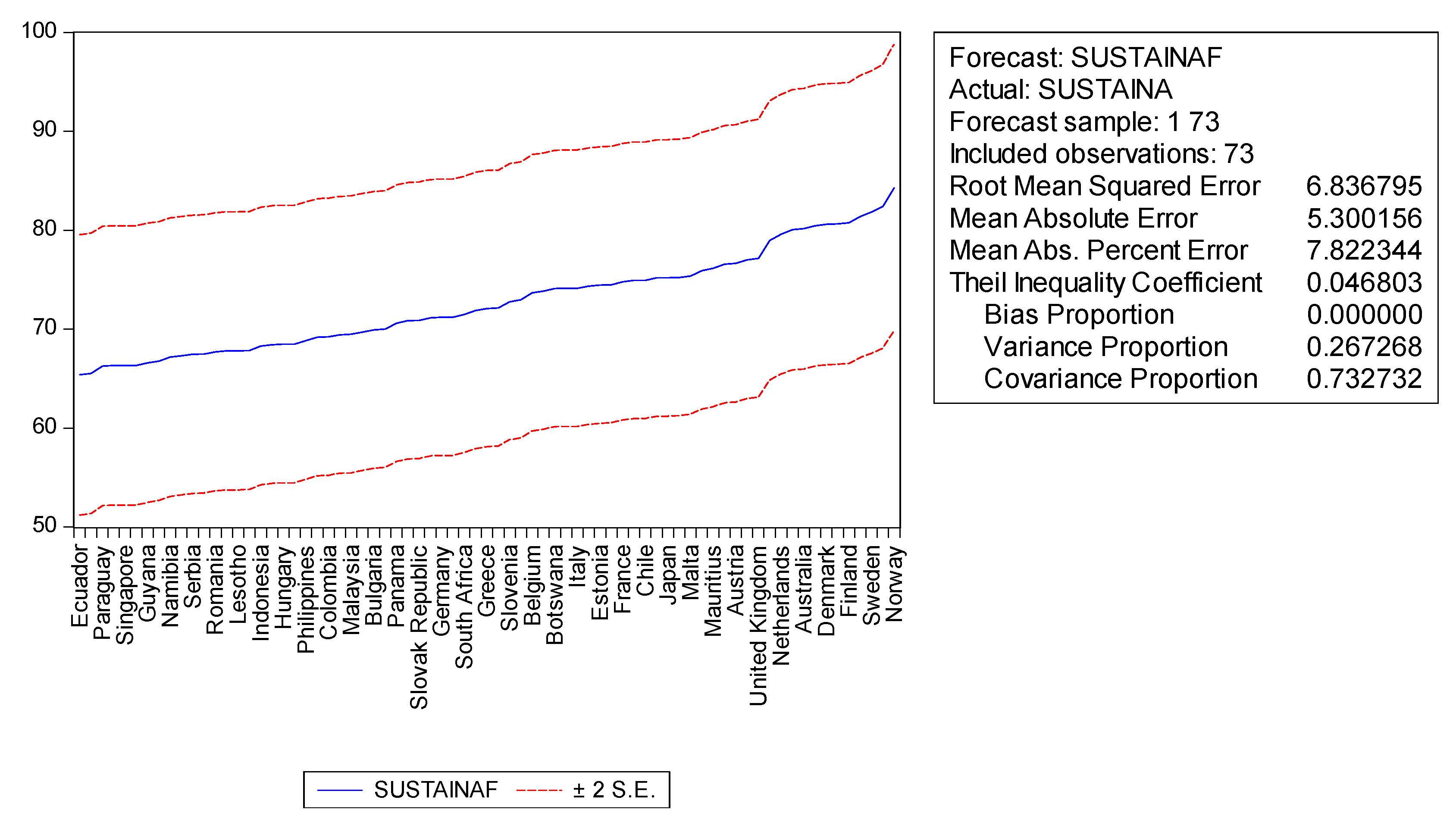
| Variable | Symbol | Measure | Data Source |
|---|---|---|---|
| Democracy Index | DI | [0; 10] | The Economist Intelligence Unit [79] |
| SDG Index Score (Sustainable Development Index) | SD | [0; 100] | Sustainable Development Report [80] |
| Electoral Process and Pluralism | EP | [0; 10] | The Economist Intelligence Unit |
| Functioning of Government | FG | [0; 10] | The Economist Intelligence Unit |
| Political Participation | PP | [0; 10] | The Economist Intelligence Unit |
| Political Culture | PC | [0; 10] | The Economist Intelligence Unit |
| Civil Liberties | CL | [0; 10] | The Economist Intelligence Unit |
| SDG 1: No poverty | SDG 1 | [0; 100] | Sustainable Development Report |
| SDG 2: Zero Hungry | SDG 2 | [0; 100] | Sustainable Development Report |
| SDG 3: Good Health and well-being | SDG 3 | [0; 100] | Sustainable Development Report |
| SDG 4: Quality Education | SDG 4 | [0; 100] | Sustainable Development Report |
| SDG 5: Gender Equality | SDG 5 | [0; 100] | Sustainable Development Report |
| SDG 6: Clean Water and Sanitation | SDG 6 | [0; 100] | Sustainable Development Report |
| SDG 7: Affordable and Clean Energy | SDG 7 | [0; 100] | Sustainable Development Report |
| SDG 8: Decent Work and Economic Growth | SDG 8 | [0; 100] | Sustainable Development Report |
| SDG 9: Industry Innovation and Infrastructure | SDG 9 | [0; 100] | Sustainable Development Report |
| SDG 10: Reduced Inequalities | SDG 10 | [0; 100] | Sustainable Development Report |
| SDG 11: Sustainable cities and coomunities | SDG 11 | [0; 100] | Sustainable Development Report |
| SDG 12: Responsible consumption and production | SDG 12 | [0; 100] | Sustainable Development Report |
| SDG 13: Climate Action | SDG 13 | [0; 100] | Sustainable Development Report |
| SDG 14: Life below water | SDG 14 | [0; 100] | Sustainable Development Report |
| SDG 15: Life on land | SDG 15 | [0; 100] | Sustainable Development Report |
| SDG 16: Peace, justice and strong institutions | SDG 16 | [0; 100] | Sustainable Development Report |
| SDG 17: Partnership for the goals | SDG 17 | [0; 100] | Sustainable Development Report |
| Sustainable Development Index | Democracy Index | ||
|---|---|---|---|
| Mean | 66.18 | 5.55 | |
| Median | 67.92 | 5.75 | |
| Mode | 30.00 | 6.21 | |
| Std. Deviation | 11.13 | 2.18 | |
| Variance | 123.96 | 4.78 | |
| Skewness | −0.62 | −0.12 | |
| Std. Error of Skewness | 0.19 | 0.19 | |
| Kurtosis | 0.16 | −1.02 | |
| Std. Error of Kurtosis | 0.37 | 0.38 | |
| Range | 55.81 | 8.73 | |
| Percentiles | 25 | 58.40 | 3.52 |
| 50 | 67.92 | 5.75 | |
| 75 | 74.47 | 7.28 | |
| Predictors | B | Std. Error | Beta | T | Sig. |
|---|---|---|---|---|---|
| SDG 8-DECENT WORK AND ECONOMIC GROWTH | 0.063 | 0.019 | 0.439 | 3.316 | 0.002 |
| Predictors | B | Std. Error | Beta | T | Sig. |
|---|---|---|---|---|---|
| SDG 12- Responsible consumption and production | −0.032 | 0.006 | −0.469 | −5.168 | 0.000 |
| SDG 17- Partnership for goals | 0.019 | 0.005 | 0.218 | 3.727 | 0.000 |
| SDG 16- Peace, justice and strong institutions | 0.045 | 0.004 | 0.457 | 4.687 | 0.000 |
| Geographical Area | SD Variation Rate/Entropy (by Time) | SD Variation Rate/Entropy (by the Regime Type) |
|---|---|---|
| Sustainability Index Africa | 0.23 | 5.75 |
| Sustainability Index Asia | 0.21 | 4.2 |
| Sustainability Index North America | 0.08 | 1.33 |
| Sustianability Index Europe | 0.13 | 0.92 |
| Sustainability Index Central and Latin America | 0.1 | 1.25 |
| Sustianability Index Australia and New Zeeland | 0.18 | 0.01 |
Publisher’s Note: MDPI stays neutral with regard to jurisdictional claims in published maps and institutional affiliations. |
© 2022 by the authors. Licensee MDPI, Basel, Switzerland. This article is an open access article distributed under the terms and conditions of the Creative Commons Attribution (CC BY) license (https://creativecommons.org/licenses/by/4.0/).
Share and Cite
Ștefanachi, B.; Grecu, S.-P.; Chiriac, H.C. Mapping Sustainability across the World: Signs, Challenges and Opportunities for Democratic Countries. Sustainability 2022, 14, 5659. https://doi.org/10.3390/su14095659
Ștefanachi B, Grecu S-P, Chiriac HC. Mapping Sustainability across the World: Signs, Challenges and Opportunities for Democratic Countries. Sustainability. 2022; 14(9):5659. https://doi.org/10.3390/su14095659
Chicago/Turabian StyleȘtefanachi, Bogdan, Silviu-Petru Grecu, and Horia Costin Chiriac. 2022. "Mapping Sustainability across the World: Signs, Challenges and Opportunities for Democratic Countries" Sustainability 14, no. 9: 5659. https://doi.org/10.3390/su14095659
APA StyleȘtefanachi, B., Grecu, S.-P., & Chiriac, H. C. (2022). Mapping Sustainability across the World: Signs, Challenges and Opportunities for Democratic Countries. Sustainability, 14(9), 5659. https://doi.org/10.3390/su14095659





